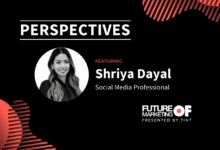If your marketing feels salesy, you’re doing it wrong.
That salesy feeling comes from self-promotional content. This is the content created in board rooms that miss the mark. It’s the content written from your brand voice, clearly put there to sell products.
Here’s the thing about marketing: you need brand-created content.
You need the strategic copywriting formulas, call to actions, and A/B tested headlines. These techniques are based on foundational psychology principles that marketers can’t ignore – but too much of this brand voice can be a bad thing. It can turn customers away, giving them the impression that you’re just a company after their wallet instead of a trusted friend with a solution to their problem.
Who does your customer trust?
- Their friends
- Their family
- Their social network
Adding in the voices of these trusted confidants is where your brand voice can go from salesperson to trusted friend.
Here’s how to use your community’s voice to build a relationship with your audience and outdo the competition.
How to Create the Perfect Content Mix
Marketers and brands fall into the trap of creating too much brand content because it feels like the easiest option.
You can send your copywriter your offer and customer profile information and they can create converting copy. What they can’t create is a relationship with your audience that brings in a new level of FOMO and social proof.
Your brand voice can only say so much.
- It can promote your new offers
- It can say witty things in your social media captions
- It can talk about an upcoming secret product
But it can’t talk about how great a product is, how well it works, and why a customer would buy it again in a way that a real customer can.
That’s where adding your community’s voice to your content strategy comes into play.
There are some things only you can say about your brand…and there are others only your audience can.
Blending your community’s voice with your brand voice can lead to more engagement on your content, longer times spent on your website, and higher conversion rates.
TikTok is the proof.
On TikTok, brands have blended user-generated content with branded content to create brand engagement that hasn’t been seen in years. Seeing what worked so well on TikTok has brought brands to established platforms like Instagram and Twitter to see how they can add their communities’ voices into their content there as well.
Blend Community with Brand Content
Drunk Elephant uses a content mix of brand and user-generated content on Instagram. The 5 photos below are repurposed from customers’ Instagram posts and the IGTV video is brand-created content.
Here’s how you can start adding your communities voice to your marketing channels:
Step 1: Start with a 50/50 content mix, half brand-created content and half community content.
Some brands thrive off of only posting user-generated content while others need to create branded content for offers, launches, and more. The goal of your strategy is to figure out what works best for your audience. User-generated content is a photo, video, feedback, or testimonial about your brand.
As you start adding your community’s voice to your content, aim for a 50/50 content mix of branded content and community content.
You can pull your community’s voice from user-generated content repurposed directly to your marketing channels. For example, you can take a customer-created Instagram post and post it to your social feed (like Drunk Elephant does). You’ll need permission to do this.
Step 2: Collect and organize user-generated and employee-generated content
Your brand-created content will come from your content team. User-generated content will have to be collected and organized for future use. You can find, collect, get rights to use UGC from social media, and repost it seamlessly – especially if your content team is short on budget, time, or team members (or all 3).
You can also find and curate employee-generated content. Employee-generated content (EGC) includes feedback, testimonials, updates, photos, and videos created by employees about their employer.
We see EGC all the time across Twitter, as people join new companies (and even leave them).
This content can be repurposed across a brand’s channels to showcase their employee’s voices, instead of just the brand’s.
As the creator economy continues to dominate the content space, the question of finding content to repurpose is becoming increasingly less realistic. The real question is how to find, collect, and repurpose all the content your customers and employees are making about your brand.
Step 3: Test, Test, Test
You could have guessed this would be the last step. Like any content strategy, testing is crucial to getting it just right.
When we look at Dunkin’s content strategy, we see a 100% user-generated and employee-generated feed. We can assume that Dunkin has done extensive testing and data collecting to figure out that their audience doesn’t want to see branded content on these channels.
With Drunk Elephant, we can see their audience reacts best to user-generated content, but still needs brand-created content to give them in-depth information about new products.
How Brands Are Blending Brand and Community Voice
Delta
Delta uses brand-created content to connect with their audience on Twitter, but they also blend in employee-generated content and user-generated content to give their employees and customers a chance to have their voice heard on their platform.
For example, Delta used UGC from travelers to put together this image above their poll (check out the photo credit at the bottom of each image). Then, they added brand-created content with their tweet and poll asking which destination their audience is most looking forward to visiting.
They’ve also tied in employee-generated content with a video highlighting Delta employee Julie:
Peloton
Peloton has become a master at community building. They’re followed by 1.5 million fans on Instagram and even have a meme Instagram account with over 280,000 followers that are not even affiliated with the brand. This affiliate account gives Peloton a huge amount of user-generated content to share with their audience (if they choose).
Here’s an example of Peloton’s employee-generated content. This video talks about their new instructor, Callie Gullickson, and gives a background story on her past as a dancer:
They also repost plenty of user-generated content from their customers. You’ll find tons of photos of happy Peloton customers enjoying their workout. Each post includes the caption from their customer’s initial Instagram post, sharing their community’s voice with their 1.5 million people following.
And then we have Peloton’s branded content… content based on their brand voice designed specifically for their audience.
Your Customers Want You To Blend Your Brand and Community’s Voice
Marketing channels are no longer a sacred space where only a brand’s voice can live. As the creator economy continues to make sharing our brand experiences the norm, more and more of your audience, fans, and customers will be sharing their happy experiences with your products.
To not highlight their experience would be a disservice to one of the most important marketing techniques of all time: social proof.
Start using a blend of brand-created content and community-created content across your marketing channels to test how each performs. Find the right balance of each to see your engagement, click-throughs, and conversions increase.
Want more actionable marketing advice like this? Subscribe to the Future of Marketing to join over 25,000 marketing leaders studying what’s working in marketing today and learn how to take your strategy to the next level.





